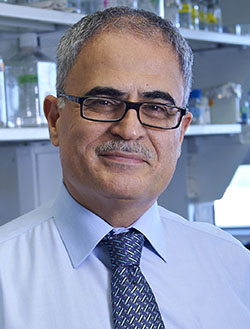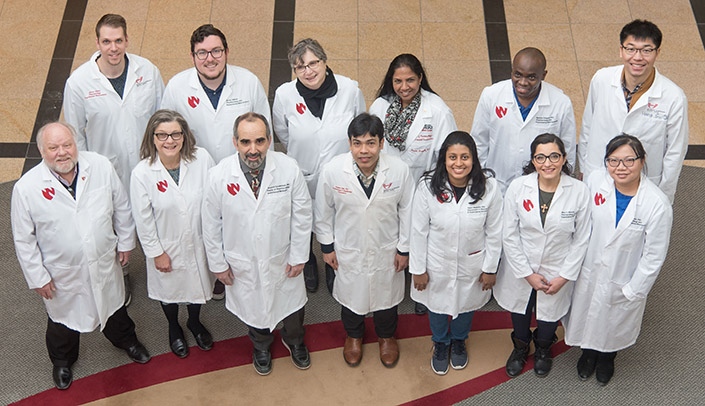Editor’s Note: Within hours of Tuesday’s announcement, news of the breakthrough study appeared in media outlets around the world, including CNN, CNBC, Time, London’s Daily Mail and New Scientist magazine.
 |
Kamel Khalili, Ph.D., of Temple University |
In a major collaborative effort, researchers at UNMC and the Lewis Katz School of Medicine at Temple University (LKSOM) have for the first time eliminated replication-competent HIV-1 DNA — the virus responsible for AIDS — from the genomes of living animals. The study, reported online July 2 in the journal Nature Communications, marks a critical step toward the development of a possible cure for human HIV infection.
“This achievement could not have been possible without an extraordinary team effort that included virologists, immunologists, molecular biologists, pharmacologists, and pharmaceutical experts,” said Howard Gendelman, M.D., Margaret R. Larson Professor of Infectious Diseases and Internal Medicine, chair of the UNMC Department of Pharmacology and Experimental Neuroscience and director of the Center for Neurodegenerative Diseases. “Only by pooling our resources together were we able to make this groundbreaking discovery.”
What others are saying
“In my view, this is the most interesting and important therapy-related research advance I have seen in many, many years. Congratulations to the authors.”
-Robert Gallo, M.D., co-founder and director, Institute of Human Virology at the University of Maryland School of Medicine and The Homer & Martha Gudelsky Distinguished Professor in Medicine and scientific director of the Global Virus Network. In 1984, Dr. Gallo co-discovered HIV as the cause of AIDS.
“Our study shows that treatment to suppress HIV replication and gene editing therapy, when given sequentially, can eliminate HIV from cells and organs of infected animals,” said Kamel Khalili, Ph.D., Laura H. Carnell Professor and chair of the Department of Neuroscience, director of the Center for Neurovirology, and director of the Comprehensive NeuroAIDS Center at LKSOM.
Drs. Gendelman and Khalili were senior investigators on the new study.
Current HIV treatment centers on the use of antiretroviral therapy (ART). ART suppresses HIV replication but does not eliminate the virus from the body. Therefore, ART is not a cure for HIV, and it requires lifelong use. If it is stopped, HIV rebounds, renewing replication and fueling the development of AIDS. HIV rebound is directly attributed to the ability of the virus to integrate its DNA sequence into the genomes of cells in the immune system, where it lies dormant and beyond the reach of antiretroviral drugs.
In previous work, Dr. Gendelman’s team used a therapeutic strategy known as long-acting slow-effective release (LASER) ART co-developed by Benson Edagwa, Ph.D., assistant professor of pharmacology at UNMC.
Dr. Khalili’s team used CRISPR-Cas9 technology to develop a novel gene editing and gene therapy delivery system aimed at removing HIV DNA from genomes harboring the virus. In rats and mice, they showed that the gene editing system could effectively excise large fragments of HIV DNA from infected cells, significantly impacting viral gene expression. Similar to ART, however, gene editing cannot completely eliminate HIV on its own.
For the present study, Dr. Gendelman and his team led by Prasanta Dash, Ph.D., instructor of pharmacology, combined its LASER ART strategy with the gene editing system.
LASER ART targets viral sanctuaries and maintains HIV replication at low levels for extended periods of time, reducing the frequency of ART administration. The long-lasting medications were made possible by pharmacological changes in the chemical structure of the antiretroviral drugs. The modified drug was packaged into nanocrystals, which readily distribute to tissues where HIV is likely to be lying dormant. From there, the nanocrystals, stored within cells for weeks, slowly release the drug.
Dr. Khalili said, “We wanted to see whether LASER ART could suppress HIV replication long enough for CRISPR-Cas9 to completely rid cells of viral DNA.”
To test their idea, the researchers used mice engineered to produce human T cells susceptible to HIV infection, permitting long-term viral infection and ART-induced latency. Once infection was established, mice were treated with LASER ART and subsequently with CRISPR-Cas9. At the end of the treatment period, mice were examined for viral load. Analyses revealed complete elimination of HIV DNA in about one-third of HIV-infected mice.
“The big message of this work is that it takes both CRISPR-Cas9 and virus suppression through a method such as LASER ART, administered together, to produce a cure for HIV infection,” Drs. Gendelman and Khalili said in a shared statement. “We now have a clear path to move ahead to trials in non-human primates and possibly clinical trials in human patients within the year.”
“The ability to excise HIV-1 DNA from the genomes of infected animals depends on LASER ART’s abilities to maximally restrict ongoing infection. This concept of combining both modalities provides a pathway forward to future studies in humans,” Dr. Gendelman said.

I knew you could do it!
This is awesome!
Thank God For Your Efforts Gonna Change The World We Live In And GodBless Your Persistence in finding a Cure For Aids Great Work
How much time sir hiv medicine available for patient s
This are great minds may God bless you
I am very happy, God bless you Doctors
When will human trials begin?
I know maybe you wont notice my message.
But i really really want to thank you all there at University of Nebraska Med. Center for your unceasing determination for HIV cure.
The world needs nebraska's cure for HIV.
Im hoping that it could be used sooner 😢😢😢💔
In the philippines HIV rates becomes higher and higher :'(
Im really praying for more success for nebraska and hoping HIV cure will be accessible the sooner. :'( 💔💔💔
I just wan't to say this with a noble and thankful heart. I really wish you more success and hope that the cure imerges from your university. I know that companies that gain profit from HIV will come and try to manipulate your brains not to release the cure. But i pray you don't fall for it and that you will be what we in world needs. Congrats from Africa "Namibia" . And please read about some drug called COA72, i think it will be worth it.
Please save us all.
Great job done…Congratulations to the entire team…Nothing is impossible… You all are Living gods….Plz save mankind….
Are there any new updates regarding this news?
Awesome💪😃😃, I now believe that there's nothing impossible, these doctors are heaven sent.. Finally HIV will eventually come to an end. Thank you! May you please start human trials asap.